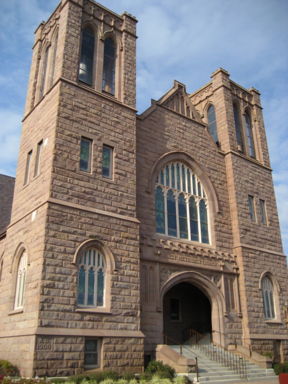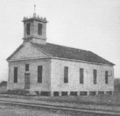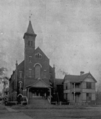First United Methodist Church
| First United Methodist Church of Pensacola | |

| |
| Denomination | Methodist |
|---|---|
| Organized | December 7, 1821 |
| Senior Minister | Rev. Dr. Geoffrey D. Lentz |
| Location | 6 East Wright Street |
| Previous locations | NE corner Tarragona and Intendencia Streets NW corner Palafox and Garden Streets |
| Website | www.pensacolafirstchurch.com |
| <googlemap version="0.9" lat="30.417221" lon="-87.215652" zoom="16" width="300" height="250">
30.417032, -87.215583 First Methodist Church </googlemap> | |
The First United Methodist Church or First Methodist Church is a historic church in Pensacola, currently located at 6 East Wright Street. The church's current pastor is the Reverend Dr. Geoffrey D. Lentz.
Contents
History[edit]
The early church[edit]
Spain, a Catholic nation, controlled Florida prior to 1821, and did not permit open congregations of Protestantism. The transfer of Florida to the United States in 1821 opened the door for Protestant churches to establish a presence in Pensacola.
On December 7 of that year, the Mississippi Conference of the Methodist Church, in session at Washington, Mississippi, established a mission to Pensacola; the Reverend Dr. Alexander Talley was appointed as the mission's first pastor. Talley served for about a year before being relieved by Rev. Ashley Hewett, who in turn was succeeded by Rev. Dr. Henry P. Cook. Without a permanent home, church services were held in public buildings as well as in a theatre. The March 20, 1824 issue of the Pensacola Gazette mentions a service held at the courthouse.
Rev. Dr. Cook died of yellow fever in the fall of 1825, and was replaced by Rev. Dr. John R. Lambuth, but Rev. Lambuth's tenure did not last long, for the mission was transferred to the South Carolina Methodist Conference in 1826. It was during the service of the next pastor, Rev. Dr. Charles Hardy, that the South Carolina conference approved funds for construction of a permanent home for the church.
The first permanent home[edit]
On May 26, 1827, a lot on the northeast corner of Tarragona and Intendencia Streets was purchased,[1] at which a permanent home for the church was built, with the first services held on June 22, 1828.[2] Several months prior, on February 14, 1828, Rev. Isaac Boring had been appointed to take over the church from Rev. Hardy; Rev. Boring arrived in Pensacola on March 12 and sold his horse to Rev. Hardy for $100, so that Rev. Hardy would have transportation to his next destination.
Rev. Adam Wyrick took over in 1829; he wrote of Pensacola: "... a most terribly ... wicked place. Can see little evidence of good being accomplished." His successor, Rev. Dr. John W. Talley, was the last pastor sent by the South Carolina conference; the Pensacola-Escambia mission was again transferred in 1831, this time to the Georgia conference, who sent as pastor Rev. P. C. Shelman.
This first church suffered two fires. The first, in 1858,[3] damaged but apparently did not destroy the building, and repairs were completed by the following year. The building was burnt to the ground in 1862[4] or 1864,[5] but was rebuilt in 1870. In 1881 the property was sold[6] and the church constructed a new facility on the northwest corner of Palafox and Garden Streets.
Second building[edit]
Construction began on the new church building, a three-story Romanesque Revival structure, in the fall of 1881. For the next two and a half years, the congregation was without a permanent home:
| While without a church we worshipped in the Baptist church until we moved into Pou's Hall ... We worshipped there two years or more, paying $25 per month rent. In the spring of 1884 we moved into the basement of [the new] church. | ||
—Mary Lucia Richards, "Methodism in Pensacola" [7] | ||
The building was completed in 1890.[8] In 1906, the property was sold, and the church building demolished, to make way for the San Carlos Hotel; and the church thereafter moved to its current site on Wright Street.
Current facilities[edit]
The sanctuary[edit]
Stephen Fagin Fulghum was chosen to build the new sanctuary; the cornerstone was laid on October 14, 1908. Services were held at Hannah Hall on Romana Street until the current building was completed in 1910. The first service was held at the completed church on October 30, 1910.
Between 1997-99, the sanctuary was renovated; its roof was replaced, its sandstone walls were cleaned with acid, and restoration work was carried out on its stained glass windows. Due to damage from Hurricane Ivan in 2004, the sanctuary roof was once again replaced in 2005.
In 2002, a new pipe organ was dedicated; the organ is "the largest and most comprehensive pipe organ in [the] area with 73 ranks of pipes and weighing some 50,000 pounds. This organ consists of a four-manual and pedal ebony console, a solid white oak case plus 4,153 pipes."
Other facilities[edit]
In 1951, an Education Building was constructed. In 1959, the Chapel of the Good Shepherd was built in memory of W. C. Mackey and E. R. Malone. "The Ark", a youth activity center, opened in 1980, followed by The Wright Place in 1983. A new administrative building was constructed between 1988-89, linking the sanctuary to The Wright Place. In the early 1990s, the church acquired property on Wright Street from a bankrupt car dealership and transformed it into a seventy-car parking lot for its members.
In 2000, the Church purchased two buildings across Wright Street, the former Fisher-Pou Funeral Home and a former Baptist Church, which became their Youth Ministry Center and Outreach Ministry Center, respectively. In 2004 as a result of the Church's "Build on the Dream" capital project, a new three-story lobby building was completed. The lobby has connections to the sanctuary, library, Henry Roberts Activity Center, Wright Place, and the Education Building.
Facilities
View a campus map
Main Sanctuary Built in 1908, this impressive gothic-revival structure with classic brownstone exterior is a landmark structure in downtown Pensacola. Home to three of our Sunday morning services, the sanctuary seats approximately 600. Remodeled in 2001, the sanctuary now is home to one of the largest pipe organs in the area, containing 4,153 individual pipes. Over 100 individual sections of beautiful restored stained glass frame the building with light. In 2008 the centennial cornerstone time capsule was opened. Its contents are now on display in the Governor Perry Home. A new time capsule was also placed, to be opened in 2108.
Governor Perry Home Built in 1867, by Charles Boyson, this neo-greco styled home was later purchased and completed by Edward Perry, governor of Florida. Acquired by the church in 2008, the historic Governor Perry Home has been restored to include a number of meeting spaces, classrooms and and the Perry Home Coffee House.
Wesley Abbey Wesley Abbey is home to our newest Sunday service called ICON. Originally built by the Scottish Rite Masons in 1955, Wesley Abbey was remodeled in 2008 and now includes state-of-the-art audio, video and lighting and seats approximately 350. Wesley Abbey is directly behind the Governor Perry Home and is connected by a central lobby. A north lobby on Belmont Street with covered connector to the main church building was also added to provided greater connectivity as a campus. ICON will eventually relocate to a larger room on the second floor, which will seat 600.
Main Lobby / Administration Constructed in 2001, the main lobby provides quick access to the majority of our campus. The church office is located directly ahead once entering through the main lobby. Elevator and stair access is available to the four floors of the main building. In the basement you will find our exhaustive church library and multiple classrooms. The ground floor has offices and access to The Wright Place, Henry Roberts Activity Center and the Children’s Education Building. The second floor provides access to the Sanctuary, Chapel, and Sr. Pastor’s study. The third floor contains our music ministry, with large choir rehearsal room, handbells and more.
The Wright Place and Henry Robert’s Activity Center In the early 1980’s, First Church acquired the Rhodes-Collins Furniture company and renovated the building and attached warehouse to be used as a mutlipurpose fellowship hall. Wednesday Night Dinners, large gatherings and other events are held in The Wright Place. The Henry Robert’s Activity Center is used for general recreation for preschool, children and youth and events.
Children’s Education Building Built in 1951, the two story Children’s Education Building is home to our children’s ministry program. On the first floor, the nursery, classrooms, and our half-day preschool, the Learning Enrichment Program can be found. The second floor contains our children’s library, children’s worship room, classrooms, children’s director’s office and more.
Youth Building Originally the Fisher-Pou Funeral Home, First Church acquired and renovated the two story building in 2000 to house our growing Youth Ministries. The first floor contains a lobby, large gathering room, cafe, kitchen and youth director’s office. The second floor has a game room and multiple classroom for Sunday School and small groups.
Noah’s Ark Learning Center Our full day preschool, Noah’s Ark Learning Center, is located directly behind the Henry Roberts Activity Center at the corner of Belmont and Guillemard. A preschool playground and additional parking are located next to the building.
Outreach Ministry Center In May, 2000 First Church acquired the building formerly owned by an independent church. The Outreach Ministry Center is now home to adult Sunday School classes, a non-profit recovery organization, Suit Yourself (clothes closet for underprivileged women entering the work force), and our Feeding the Hungry Program. Feeding the Hungry provides hot meals for over 100 of the areas homeless twice a week.
In 2007, the Church purchased the adjacent Scottish Rite Masonic Center, which presently is home to ICON, a contemporary style service.
Missions[edit]
Several other area Methodist churches began as missions of First Methodist, including Gadsden Street United Methodist Church, Cokesbury United Methodist Church and St. Andrew United Methodist Church.
Church leaders[edit]
- Rev. Dr. Alexander Talley (1821-1822)
- Rev. Ashley Hewett (1823)
- Rev. Dr. Henry P. Cook (1824-1825)
- Rev. Dr. John R. Lambuth (1825-1826)
- Rev. Dr. Charles Hardy (1826-1828)
- Rev. Isaac Boring (1828)
- Rev. Adam Wyrick (1829)
- Rev. Dr. John W. Talley (1830)
- Rev. P. C. Shelman (1831)
- Rev. G. W. Collier (1832)
- Rev. Joseph B. Cottrell (1854-1855)
- Rev. Theophilus Moody (1857)
- Rev. David M. Hudson (1858, 1873-1874)
- Rev. W. K. Norton (1859-1860)
- Rev. Thomas A. Hopkins (1861)
- Rev. Anson West (1862)
- Rev. W. H. Carter (1866)
- Rev. J. A. Parker (1868)
- Rev. E. B. McClelland (1869)
- Rev. John A. Pace (1870-1872)
- Rev. Philip H. Lightfoot (1876-1878)
- Rev. C. B. DuBose (1879-1882)
- Rev. W. M. Cox (1888-1891)
- Rev. C. W. Gavin
- Rev. Dr. Henry Earle Roberts (retired June 2006)
- Rev. Dr. Wesley H. Wachob (retired June 2022)
- Rev. Dr. Geoffrey D. Lentz (current)
Other images[edit]
References[edit]
- About First United Methodist Church
- King, M. Luther. "Church History of Santa Rosa County: Some Sketches of Methodism." Friends of Pace Library. Retrieved on 2008-12-19.
- ↑ Abercrombie, Lelia (January 1959). "Early Churches of Pensacola". Florida Historical Quarterly, p. 453.
- ↑ Hoskins, Frank W. (1928). The History of Methodism in Pensacola, Florida: Its Rise and Progress. Cokesbury Press. p. 45.
- ↑ Abercrombie, p. 454.
- ↑ Abercrombie, p. 454.
- ↑ Hoskins, p. 77.
- ↑ Hoskins, p. 81.
- ↑ Hoskins, p. 81.
- ↑ Escambia County. Florida Historical Markers Progam. Retrieved 2008-12-19.

